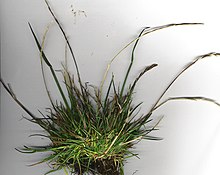Schedonorus
| Lolium | |
|---|---|
 |
|
| perennial ryegrass (Lolium perenne) | |
| Scientific classification | |
| Kingdom: | Plantae |
| Clade: | Angiosperms |
| Clade: | Monocots |
| Clade: | Commelinids |
| Order: | Poales |
| Family: | Poaceae |
| Subfamily: | Pooideae |
| Tribe: | Poeae |
| Subtribe: | Loliinae |
| Genus: |
Lolium L. |
| Synonyms | |
|
|
Lolium is a genus of tufted grasses in the bluegrass subfamily of the grass family. It is often called ryegrass, but this term is sometimes used to refer to grasses in other genera.
They are characterized by bunch-like growth habits. Lolium is native to Europe, Asia and northern Africa, as well as being cultivated and naturalized in Australia, the Americas, and various oceanic islands. Ryegrasses are naturally diploid, with 2n = 14, and are closely related to the fescues (Festuca).
Ryegrass should not be confused with rye, which is a grain crop.
Several species now regarded as better suited to other genera: Castellia Enteropogon Festulolium Hainardia Lepturus Melica Vulpia
Lolium contains some species which are important grasses for lawns, and as pasture and for grazing and hay for , being a highly nutritious stock feed. Ryegrasses are also used in soil erosion control programs. It is the principal grazing grass in New Zealand where some 10 million kilograms of certified seed are produced every year. There is a large range of cultivars. The primary species found worldwide and used for both lawns and as a forage crop is perennial ryegrass (Lolium perenne). Like many cool-season grasses of the Poaceae, it harbors a symbiotic fungal endophyte, either Epichloë or its close relative Neotyphodium, both of which are members of the fungal family Clavicipitaceae.
...
Wikipedia
